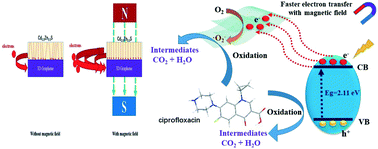Highly efficient photocatalytic degradation of the emerging pollutant ciprofloxacin via the rational design of a magnetic interfacial junction of mangosteen peel waste-derived 3D graphene hybrid material†
Abstract
Suppressing the recombination of light-induced carriers in semiconductor photocatalysts is crucial but challenging for high-activity photocatalysis. In addition to the current substantially developed strategies, such as the built-in field of catalytic heterostructures, other promising alternatives need to be explored. Herein, a mangosteen peel waste-derived 3D graphene hybrid material with a magnetic interfacial junction was constructed to obtain insights into its highly efficient photocatalytic performance by boosting carrier transfer efficiency with the assistance of a magnetic field. The spin-related behavior of the ferromagnetic alignment of the magnetic interfacial junction of the designed 3D graphene/Cd0.5Zn0.5S hybrids plays an essential role in improving the photocatalytic performance, with ciprofloxacin degradation efficiency reaching 95% removal in 15 min, which is a 67% reduction in photocatalytic degradation time. This photocatalytic performance is outstanding in comparison to previous research without an applied external magnetic field. With low energy consumption, this magnetic field strategy provides a new perspective for water treatment as well as various catalytic fields.

- This article is part of the themed collection: Environmental Science: Nano Recent HOT Articles


 Please wait while we load your content...
Please wait while we load your content...